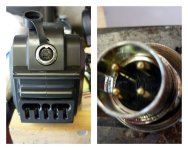Here's another way to look at it... you're out riding, giving it full throttle, and its slightly down hill, and your wheel RPM goes up to 450ish. You will then be drawing 1.8 amps. Then you start going up hill. As the wheel starts slowing down, and you keep the throttle at max, more amps start flowing thru the windings as the RPM drops and the back EMF goes down. As the hill gets steeper, you hit a point where wide open throttle only produces 174 RPM because of the load of the hill, and it's taking almost 30 amps to keep it at that RPM as you climb. So its not that the higher amps are causing the slow down, its that a load on the system that's forcing the motor to lower RPMs gets higher amps flowing.


